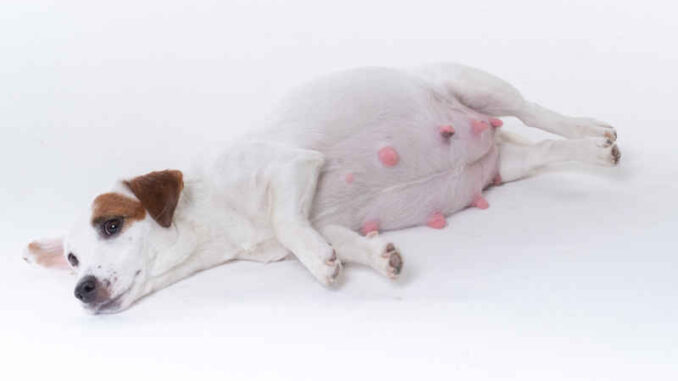
This article was updated on January 16th, 2024
Dog pregnancy, both intentional and unintentional, is common in unspayed females. Last month, I spoke with an owner about the physical changes that we see in pregnant dogs. Several of her questions revolved around changes to the dog’s nipples. In this article, I’ll explain what happens to a dog’s nipples during pregnancy (with several pictures to illustrate).
Dog Nipples During Pregnancy – What Happens?
Prior to pregnancy, a dog’s nipples are very small. They tend to be somewhat flat and pale in color. In some dogs, the nipples are so small that they can be mistaken for a tick or other bug attached to the pet.
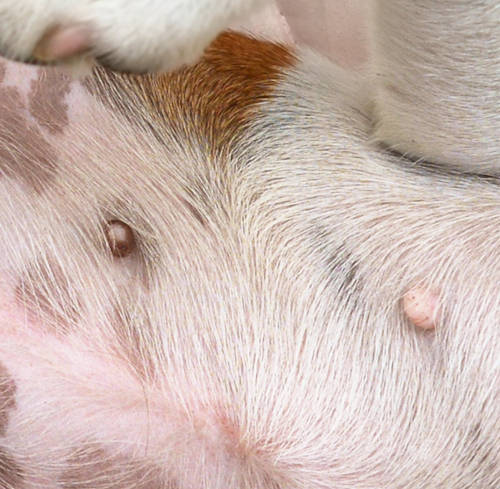
During pregnancy, several changes may be noted to the nipples.
Pink color: one of the common changes seen is they become more pink and enlarged. This is a result of increased blood flow to the area to allow for mammary development. In darkly pigmented dogs, a pink color change may not be seen, but rather the nipples may become more darkly pigmented.
Enlargement: Enlargement of the nipples in darkly colored dogs will still also occur.
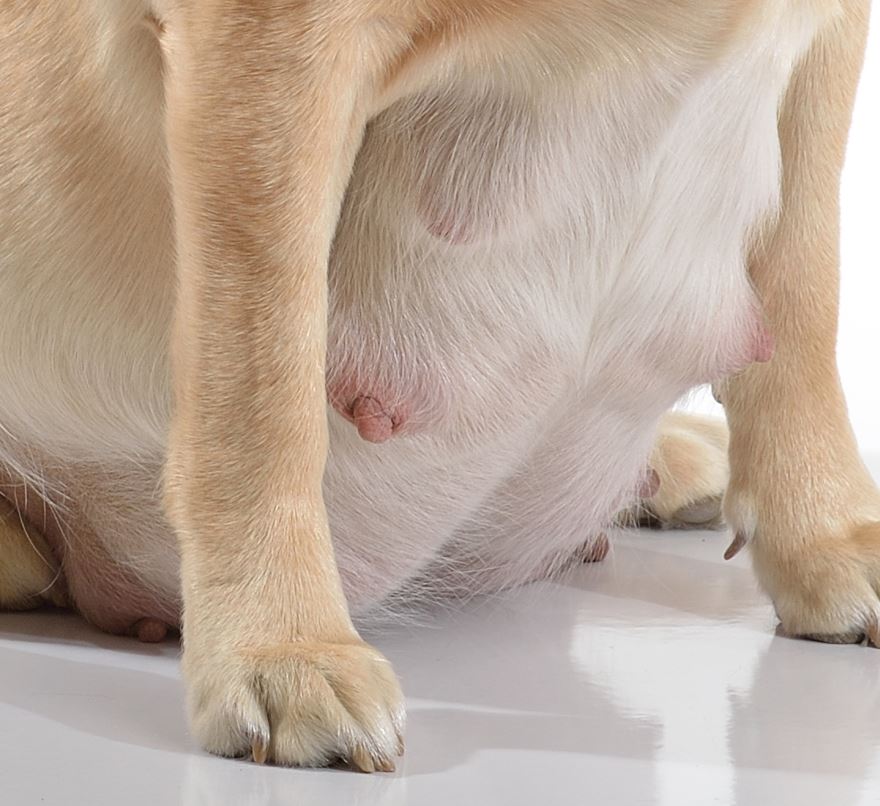
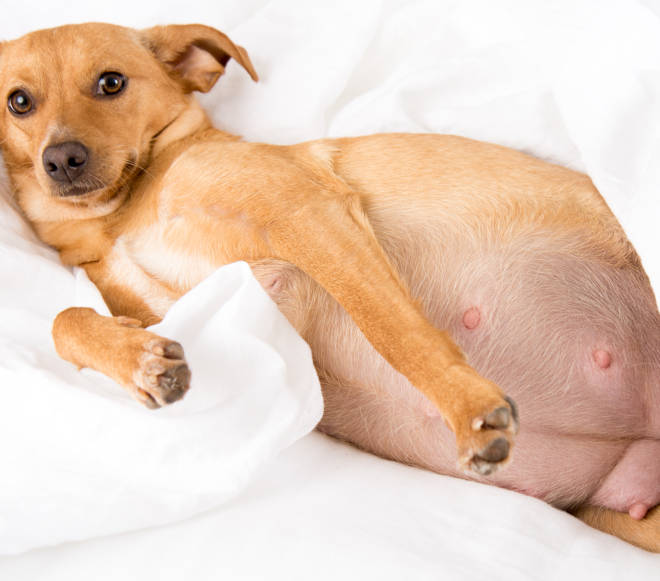
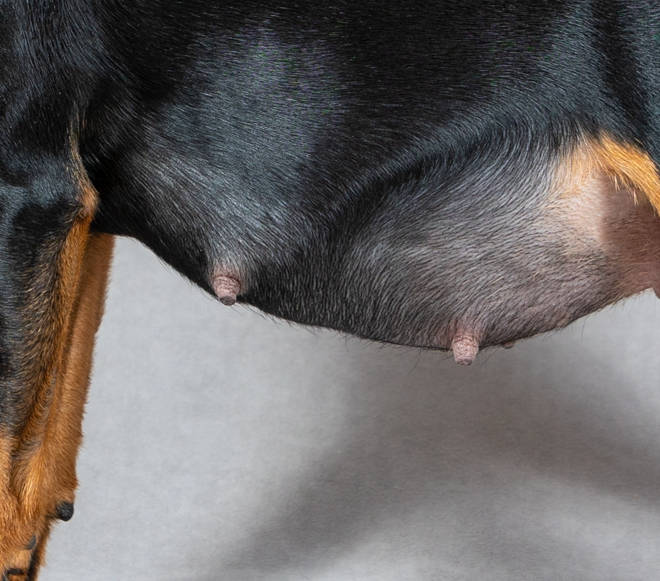
Normal Vs Pregnant Dog Nipples
Below are pictures comparing normal vs pregnant dog nipples. In the first few weeks, the difference is only subtle:
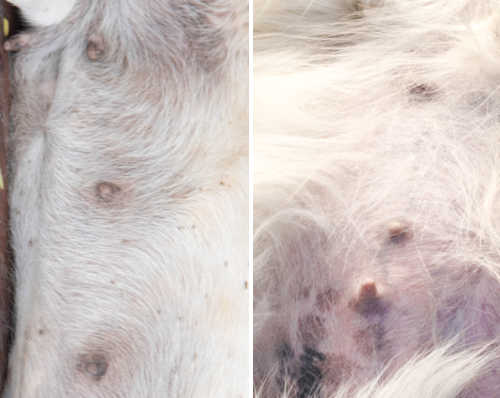
As the pregnancy evolves, the difference becomes more noticeable:
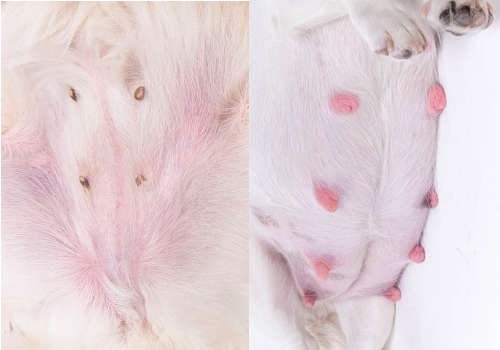
You can also view our dog pregnancy pictures (week by week).
As pregnancy progresses:
- The nipples start to lengthen and look more pendulous like the udder of a cow.
- You may even be able to gently express small amounts of milk from the nipples.
- In the late stages of pregnancy, enlarged nipples, as well as enlarged mammary glands and a distended abdomen, will be noted. Milk can easily be expressed from the nipples at this point.
Note that in females that have already had previous litters, their nipples may always look like this making it difficult to assess if there is pregnancy or not.
To learn about the best ways to find out if your dog is pregnant, read our article: Is My Dog Pregnant? Early Signs, or read the next section.
Can You Tell If Your Dog is Pregnant Based on the Nipples?
Most of the time, you can’t. While nipples will always change with pregnancy, nipple changes don’t necessarily mean that a dog is pregnant. Nipple enlargement can be seen simply when:
- A female is in heat
- A female is ready to be bred
- A female has had previous litters of puppies
Nipple enlargement and even milk production can also be seen with cancers that affect the reproductive system as well as pseudopregnancies (“false pregnancies”). To find out if your dog is pregnant, read our article: Is My Dog Pregnant? Early Signs and Home Tests to Find Out.
Other Signs that Your Dog is Pregnant
If seeing nipple changes at home and the dog had an opportunity to be bred, you may watch for other signs that may confirm the suspicion of the pet being pregnant.
- Changes in appetite – initially may be picky, but then becoming more hungry
- Changes in behavior – may become more clingy, anxious, or even aggressive
- Changes in structure – distention of abdomen as the uterus becomes enlarged with puppies
- Changes in energy levels – may spend more time napping or seem more lethargic
Without some of these other changes, it can be difficult to know if changes being seen with the nipples are related to pregnancy or other health conditions. An easy way to assess is to do a home pregnancy test. It is best to wait at least a month after the pet has been possibly bred to get the most accurate results.
Consulting with a veterinarian is another way to help determine if the pet may be pregnant. They may recommend doing an ultrasound or x-rays depending on how far along the pet may be.
Of course, the old-fashioned way of just waiting will usually give an answer too. The gestation of the dog is very short with most dogs having puppies around 63 days after being bred. Give it a couple of months and if your dog didn’t have puppies, it was likely not pregnant.
During Pregnancy, Monitor Your Dog’s Nipple Health
Keep an Eye Out for Abnormal Redness, Bleeding, Hard Lumps or Nipple Discharge
Most dogs do not seem to be bothered by the changes to their nipples during pregnancy. In fact, it is typically during the postpartum setting that the nipples start to become uncomfortable.
Still, it is important to be aware of things that may cause concern in the nipples during pregnancy. If you know your pet is pregnant already, you should consult your veterinarian if you are noticing:
- bleeding
- hard lumps along the mammary glands and nipples
- a foul smell or discharge from the nipples
- excessive swelling or redness
- any unusual growths, sores, or ulcers on the nipples
Any of the signs above could indicate mammary duct obstruction, mastitis, or a mammary gland infection.
Learn more: view our dog pregnancy pictures (week by week).
Disclaimer: This website's content is not a substitute for veterinary care. Always consult with your veterinarian for healthcare decisions. Read More.

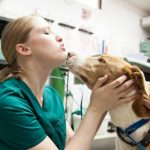
Be the first to comment